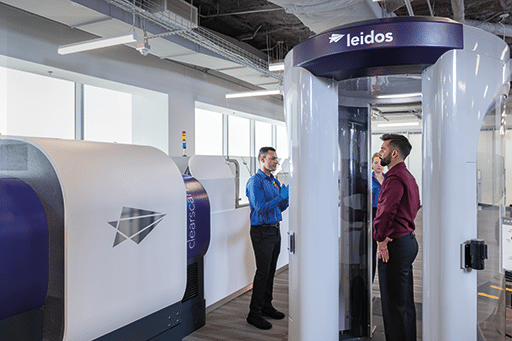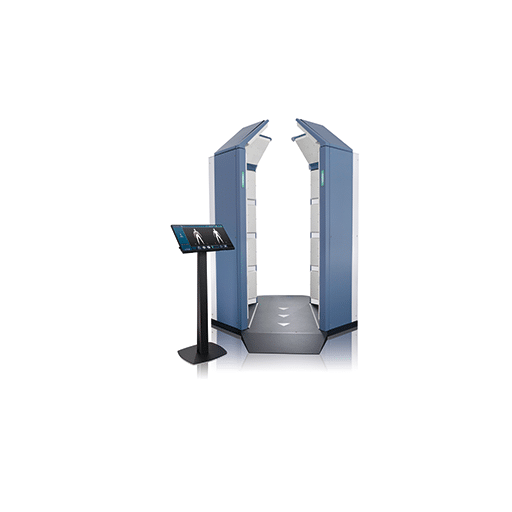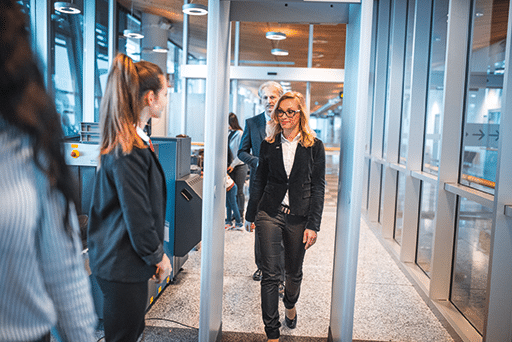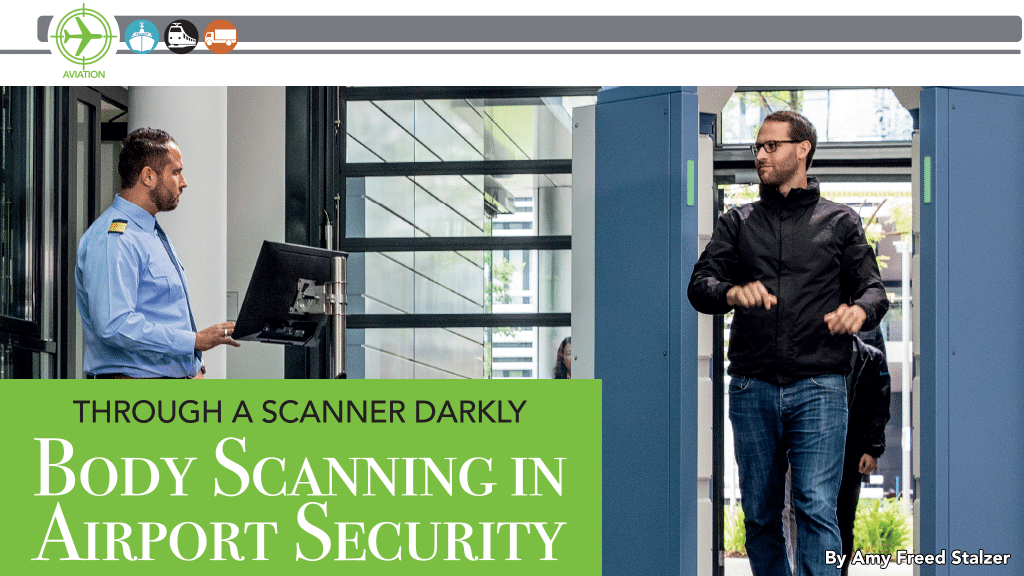Though the COVID-19 pandemic has been hugely disruptive to travel and other global industries over the past three years, it has taken place during a period of technological advancement and societal change touching all aspects of daily life. As air travelers have gradually returned to the skies in ever-increasing numbers, commercial aviation passengers now have higher expectations for their travel experience than ever before – including the airport security experience.
Since the introduction of the first backscatter x-ray body screener in the 1990s, and especially following the events of 9/11 when countries drastically overhauled their airport security procedures, body scanning machines have evolved significantly in a relatively short period of time. These tools have not been without controversy at times, sparked by passengers seeking greater privacy and fair practices during the screening process, but today’s machines are designed to mitigate such concerns.
As this technology continues to move forward in leaps and bounds to speed up scanning times, increase detection abilities and improve the passenger experience, some countries are now adopting the latest solution for safeguarding people and planes at airport facilities, in the form of millimeter wave imaging using advanced imaging technology (AIT).
According to the U.S. Transportation Security Administration (TSA), AIT safely screens passengers without physical contact for both metallic and non-metallic threats that may be concealed under a passenger’s clothing. Today’s AIT offers threat detection software and algorithms that can detect explosives, weapons and dangerous items, and display markers on a generic human-like representative figure on a screen to show where threats are located without exposing the details of passengers’ bodies and unnecessarily invading their privacy.

Airport Body Scanners: An Overview
Full-body scanner technologies used for airport security around the world fall into three main categories: x-ray, millimeter wave and infra-red. These security tools can detect concealed objects without requiring physical contact or clothing removal.
The first body scanners developed for airport security were backscatter x-ray machines, which emit low levels of electromagnetic ionizing radiation, or low-energy x-rays, that bounce off the surface of the skin and are reflected back to the machine to detect and generate a photographic image of concealed objects. This type of x-ray scanner is still used by airports worldwide. By contrast, transmission x-ray scanners use higher dosages of radiation that pass directly through the body before being captured by detectors, providing the ability to detect objects inside body cavities, but these machines are virtually unheard of for airport use these days and more typically used by correctional institutions.
Millimeter wave body scanners use non-ionizing electromagnetic radiation in the form of low-energy, high-frequency radio waves to send energy across scanned surfaces, which reflect off the surface of the skin to be interpreted by the machine and reveal objects hidden on a body. These scanners detect threats by using one or more antennas that move around a person’s body to construct a 3D image.
Backscatter x-ray and millimeter wave machines today are the two main airport body scanner categories in use globally, but some airports are now also using infra-red thermal conductivity body scanners as a supplemental solution to identify people with elevated temperatures, as well as hidden objects.
Infra-red scanners don’t use electromagnetic radiation but instead use temperature differences on a surface to detect the objects and measure the thermal energy, or heat, emitted by a person. By flagging potentially ill individuals who have a fever, this technology became more widely adopted in some countries during the COVID pandemic when airport staff needed to quickly identify anyone spreading infection within the airport, but according to industry experts, they are not likely to replace the other two categories of scanner at airports anytime soon.
Notably, North America and Europe have largely discontinued use of backscatter x-ray units at their airports in favor of millimeter wave scanners that offer the very latest advanced imaging technology. In fact, the TSA currently has approved only two millimeter wave AIT airport scanner providers for all U.S. airports to meet its congressionally mandated automated threat detection requirements: Leidos and Rohde & Schwarz.

Scanning Solutions on the Horizon
Leidos’ flagship millimeter wave body scanner, Pro:Vision, was first in the industry over 20 years ago, and they currently have over 2,600 systems deployed worldwide.
“Airports choose Pro:Vision because of its high threat detection capabilities, low false alarm rates, image-free scanning, small footprint, ease-of-use for both passengers and operators, and TSA and EU ECAC (European Civil Aviation Conference) certifications,” said Brad Buswell, senior vice president and operations manager at Leidos. “Our systems support high throughput needs, up to 300 passengers per hour, per system.”
In February 2023, Leidos announced the TSA awarded it a contract to upgrade the agency’s full fleet of Pro:Vision AIT systems used at airport checkpoints with a new AI-based algorithm. This upgrade will impact more than 1,000 Pro:Vision AIT systems across the U.S. and help strengthen U.S. airport security with an improved threat detection methodology that will significantly reduce false alarms, which lead to unnecessary pat-downs and checkpoint inefficiencies.
Known as the Pro:Vision 3, Leidos’ new system will be commercially released this summer. “The Pro:Vision 3 has a new antenna design, improved radio frequency boards and deep-learning AI-based algorithms to increase threat detection, reduce processing time and achieve throughput rates above 400 people per hour, per system,” Buswell said, noting the upgraded system also will give passengers a more comfortable arms-down pose during the fast-screening process.
Rohde & Schwarz’s R&S QPS201 AIT system achieved TSA Qualified Products List status for the first time in mid-2022, having already been approved for use by ECAC. Currently, QPS201 passenger screening machines are being used in several U.S. international airports, including Denver (DEN), LaGuardia (LGA) and Las Vegas McCarran (LAS). Outside the U.S., more than 1,000 QPS201 units are deployed in more than 100 of the world’s busiest airports.
“The unique design and servicing capability enable several feet in reduced lane space required for passenger screening,” said Luke Olsen, business development manager for emerging technologies at Rohde & Schwarz, of the QPS201. “Faster scanning and processing speed, and lower false alarm rate enables substantial increase in footfall traffic in on-person body scanning.” The QPS201 is also wide enough to meet ADA requirements, enabling the elimination of the need for an additional ADA gate for each lane, he said.

Additionally, Rohde & Schwarz’s R&S QPS Walk2000 has recently been introduced to the North American market as a walk-through body scanning solution that allows airport staff to keep their shoes, jackets, outer coats, and hats on while walking at a normal pace through the system. The machine is capable of finding items that would not be found by a metal detector, while reducing the delays of employees performing daily job functions, according to the company.
“Both our R&S QPS201 and R&S QPS Walk2000 technologies are based on artificial intelligence (AI), machine learning (ML) and deep learning detection algorithms to allow them to be trained and tailored to meet the specific and emerging threat needs of our customers,” Olsen said.

Meeting Today’s Security Challenges
North American and European airports are using these millimeter wave scanners with advanced imaging technology to address many security challenges – some evergreen and others more specific to our current moment as the airline travel industry continues to emerge from the pandemic.
For example, like many industries worldwide, one of the biggest challenges facing the airport security sector today is hiring qualified professionals to ensure adequate staffing levels after several years of layoffs, retirements caused by generational turnover and other employment disruptions.
“Post-COVID, airports are struggling to re-hire and retain security operators,” said Buswell. “To uphold security screening processes with low staff numbers, airports are seeking automated body scanning technologies to reduce manual intervention at checkpoints. This keeps passenger throughput high while maximizing the security posture.”
Olsen likewise notes that a pressing challenge for airport security is to increase passenger capacity and throughput to meet the predicted growth in air travel in the coming years. “This goes hand-in-hand with a reduction in divestment requirements for passengers, including the ability to keep shoes, coats and belts on to reduce re-composure time after being screened,” he said.
Travelers also have higher expectations than ever before for the passenger experience, and for how digital solutions can be used to support it.
The latest millimeter wave body scanners now feature intelligent technology designed to deliver faster scans and more accurate results, leading to fewer physical pat-downs, so airport security needs are met and the passenger experience feels less invasive overall. Scanners are also moving to a more comfortable hands-down pose during the scanning process, with the QPS201 already offering that feature, and Pro:Vision adding it soon.
Because airports are continually challenged with emerging threats, it’s vital that they have body scanner technologies that can evolve and scale as needs change, Buswell said. “Systems that leverage AI and ML methodologies, with regular algorithm and software updates, are best suited to this challenge.”
Leidos’ latest Pro:Vision body scanner uses AI and ML techniques “to provide higher detection while also reducing the false positives,” Buswell said. “For the traveling public, this has reduced the wait time at security checkpoints and the number of pat-downs, while also improving the security of our transportation systems.”
Additionally, “body scanners must provide the highest level of threat detection, support high-throughput rates, be easy to operate, and non-intrusive for passengers,” Buswell said. “When any of these attributes are missed, the impact to a security checkpoint can be detrimental, resulting in a poor experience for travelers.”
A promising advancement in body scanning technology is the ability to have gender-neutral algorithms, a feature of Rohde & Schwarz’s R&S QPS201 passenger screening system. The company designed the system’s detection algorithm so that it doesn’t distinguish between anatomical differences of different genders, Olsen said.
In situations where a person’s physical anatomy doesn’t match their outward appearance, a security challenge has been to develop body scanning software capable of scanning those people accurately and minimizing false alarms. “The transgender community has had a horrific experience going through airport security for the last many years because of the way software was designed,” said Olsen, noting that many passengers in those situations have felt discriminated against when being singled out by the machines.
However, for the newest generation of body scanners, “one of the great things about machine learning is that we can train the software to understand that humans can have different physical features based on height, weight, gender, or other characteristics, so the system learns to never use those as discriminating factors in terms of how it detects explosives and guns,” Olsen said.
Olson said near-term and ongoing enhancements to AI and ML algorithms are also improving the screening process by allowing passengers to keep their religious and cultural dress and headwear on, as well as jackets, belts, and most types of shoes, and achieving the goal of reducing alarm rates for these clothing items.
The R&S QPS201 system is Rohde & Schwarz’s third generation system, a phased array scanner capable of gathering a large amount of data with each scan that results in higher definition images than ever before. High image quality is important when using intelligent algorithms, Olsen said, because “having a better image means that the system can more effectively identify and detect potential threats.”
Evolving
As new weapons evolve over time, the scanning software can be taught to recognize new types of physical objects potentially being carried by passengers by adding new scans to the existing library of images, which helps it quickly develop an understanding of new threats.
Looking ahead, body scanners will likely be doing more with integration of third-party provider solutions. For example, Rohde & Schwarz is engaged with global regulators on open-architecture algorithms to enable the hosting of third-party enhanced detection algorithms to operate on qualified platforms. “This enables the power of industry to continue to improve platform detection without compromising the baseline qualified product performance,” Olsen said.
